MG 3 machine gun
The MG 3 is a German general-purpose machine gun chambered for the 7.62×51mm NATO cartridge. The weapon's design is derived from the World War II era MG 42 Einheitsmaschinengewehr (Universal machine gun) that fired the 7.92×57mm Mauser round.[8]
| MG 3 | |
|---|---|
 MG 3 on display with a non-disintegrating DM1 belt, spare barrel resting on its Laufschützer (barrel protector) and bolt | |
| Type | General-purpose machine gun |
| Place of origin | West Germany |
| Service history | |
| In service | 1959–present |
| Used by | See Users |
| Wars | Nigerian Civil War Bangladesh Liberation War[1] Iran–Iraq War Lebanese Civil War Kurdish–Turkish conflict Second Sudanese Civil War[2] Somali Civil War Kargil War War in Afghanistan War in North-West Pakistan Syrian Civil War Boko Haram insurgency[3] Libyan Civil War War in Iraq (2013–2017)[4] Yemeni Civil War (2015–present)[5] Russo-Ukrainian War[6] |
| Production history | |
| Designed | 1959 |
| Manufacturer | Rheinmetall License-built by: Beretta, MKEK, Ellinika Amyntika Systimata, Defense Industries Organization, Military Industry Corporation, Pakistan Ordnance Factories, General Dynamics Santa Bárbara Sistemas |
| Produced | 1959–present |
| No. built | 1 million+ |
| Variants | See Variants |
| Specifications | |
| Mass | 11.5 kg (25.35 lb)[7] 27.5 kg (61 lb) (mounted on tripod) |
| Length | 1,225 mm (48.2 in) 1,097 mm (43.2 in) (without stock) |
| Barrel length | 565 mm (22.2 in) |
| Cartridge | 7.62×51mm NATO |
| Action | Recoil-operated, roller locked |
| Rate of fire | 800–950 rounds/min or 1,000–1,200 rounds/min |
| Muzzle velocity | 820 m/s (2,690 ft/s) |
| Effective firing range | 200–1,200 m sight adjustments |
| Maximum firing range | 600 m (1,969 ft) (bipod) 1,200 m (3,937 ft) (tripod mounted) 3,000 m (9,843 ft) (gun carriage) 3,750 m (12,303 ft) (terminal) |
| Feed system | 50-round non-disintegrating DM1 belt (can be combined in a drum); 100-round disintegrating DM6/M13 belt |
| Sights | Open tangent iron sights |
The MG 3 was standardized in the late 1950s and adopted into service with the newly formed Bundeswehr, where it continues to serve to this day as a squad support weapon and a vehicle-mounted machine gun. The weapon and its derivatives have also been acquired by the armed forces of over 30 countries. Production rights to the machine gun were purchased by Italy (MG 42/59), Spain, Pakistan (MG 1A3), Greece, Iran, Sudan and Turkey.[9]
History


At the end of World War II the original technical drawings and data for the 7.92×57mm Mauser chambered MG 42 were captured by the Soviets. These would eventually find their way to Czechoslovakia and Yugoslavia. Rheinmetall had to reverse engineer the first postwar machine guns from an original MG 42 machine gun.[10]
Production of the first postwar variant of the MG 42 chambered for 7.62×51mm NATO ammunition (designated the MG 1) was launched in 1958 at the Rheinmetall arms factory as requested by the Bundeswehr. Shortly thereafter, the machine gun was modified, receiving a chrome-lined barrel and sights properly calibrated for the new round; this model would be named the MG 1A1 (known also as the MG 42/58).
A further development of the MG 1A1 was the MG 1A2 (known also as the MG 42/59), which had a heavier bolt (950 g (33.51 oz) for a slower 700–900 rounds per minute cyclic rate of fire, compared to 550 g (19.40 oz)), a new friction ring buffer made suitable for using the heavier bolt. The MG 1A2 added new bolt-bounce preventing bolt catches to the action to resolve the ammunition ignition timing sensitivity of the preceding variants and was adapted to use both the standard German non-disintegrating Patronengurt DM1 ammunition belt and the American M13 disintegrating belt. Further improvements to the weapon's muzzle device, bipod and bolt resulted in the MG 1A3.
Simultaneously, wartime 7.92×57mm Mauser chambered MG 42 machine guns that remained in service were converted to the standard 7.62×51mm NATO chambering and designated MG 2.
In 1968, the MG 3 was introduced and entered production. Compared to the MG 1A3, the MG 3 features an improved feeding mechanism with a belt retaining pawl to hold the belt up to the gun when the top cover plate is lifted, an added anti-aircraft sight and a new ammunition box. MG 3s were produced for Germany and for export customers by Rheinmetall until 1979. The preceding non-MG 3 variant machine guns in the Bundeswehr inventory were gradually converted to the MG 3 standard. Some additional production of the MG 3 in Germany was carried out by Heckler & Koch.[11] The MG 3 and its variants all share a high level of parts interchangeability with the original MG 42.
MG 3s continue to be produced in Turkey and Pakistan.[12] In 2019 there were plans in Germany to produce several thousand new MG 3 receivers to keep using vehicle mounted MG 3s in the low level anti-aircraft (designated MG 3A0A1) and turret mounted (designated MG 3A1A1) roles in the near future.[13]
Operation
The German military instructs sustained fire must be avoided at all costs. In the bipod mounted light machine gun role MG 3 users are trained to fire short bursts of 3 to 5 rounds and strive to optimize their aim between bursts fired in succession. In the tripod mounted medium machine gun role MG 3 users are trained to fire short bursts and bursts of 20 to 30 rounds and strive to optimize their aim between bursts fired in succession.[14] After around 150 rounds of rapid fire, the gun operator will replace the hot barrel with a new, cooler one. Non-observance of this technical limitation renders the barrel prematurely unusable. The machine gun crew member responsible for a hot barrel change is issued protective asbestos gloves or a cloth to prevent burns to the hands.
Design details
Operating mechanism
The MG 3 is an automatic, air-cooled, belt-fed short recoil-operated firearm. It features a roller locked bolt mechanism that consists of the bolt head, a pair of rollers, the striker sleeve, bolt body and return spring. The bolt is locked securely by a wedge-shaped striker sleeve, which forces two cylindrical rollers contained in the bolt head outward, and into corresponding recesses in the extension of the breech of the barrel. On firing, both the barrel and barrel extension recoil to the rear. The resulting impact (much like a Newton's cradle) moves the carrier to the rear withdrawing the wedge and both rollers as they are cammed inward and out of their sockets by fixed cams, unlocking the bolt head. The bolt carrier and bolt then continue to the rear together guided by fixed guides while the barrel and barrel extension return to battery. Upon return of the bolt forward, the impact of the rollers against the camming surfaces on the breech carry the rollers from their seats, and, together with the surfaces on the striker sleeve, force the rollers outward, locking the bolt head into the barrel extension and ensuring a complete lock. The bolt also houses a spring-loaded casing extractor and ejector. Ejection is carried out when the ejector strikes the buffer head, sending a push forward through the ejector bar, which hits the ejector pin. This pin pushes the top of the base of the cartridge, which is still held by the extractor at the base, causing the empty casing to rotate and eject downward through the ejection chute.
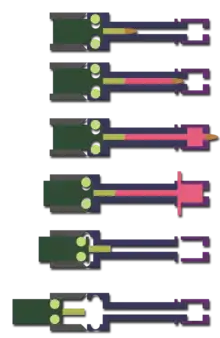 MG 3 roller-locked boosted short recoil action diagram
MG 3 roller-locked boosted short recoil action diagram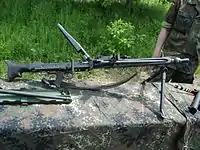 MG 3 of the German Army
MG 3 of the German Army.jpg.webp) Parts of a German MG 3
Parts of a German MG 3
Features
The machine gun has an automatic-only trigger mechanism and a cross-bolt safety in the form of a button that is operated by the shooting hand (in its "safe" position the bolt release is disabled). The weapon fires from an open bolt. The cyclic rate can be altered by installing different bolts and recoil springs. A heavier bolt uses more recoil energy to overcome inertia, thus slowing the action. On MG 3 machine guns, two types of bolts are available, with standard weight (about 650 g (22.93 oz)) for the standard 1,000–1,200 rounds per minute cyclic rate of fire[15] and with extra weight (about 900 g (31.75 oz)) for a slower 800–950 rounds per minute cyclic rate of fire. Those bolts also are used along with different return springs.[10]
The MG 3 feeds from the left side through a feed block using metal, 50-round continuous-link Patronengurt DM1 ammunition belts (which can be combined by cartridge) or disintegrating-link M13 or DM6 belts. In the light machine gun role, the MG 3 is deployed with a 100-round (or 120-round in case of disintegrating belts) belt fitted inside a synthetic ammunition drum developed by Heckler & Koch that is latched on to the left side of the receiver. The rear wall of the drum is transparent and serves as a visual indicator for the amount of ammunition available. The feed system operates through a feed arm that is housed in the feed cover. Two feed pawls are linked to the front end of the arm by an intermediate link and move in opposite directions, moving the belt in two stages as the bolt moves back and forward during firing.
For the light machine gun role the MG3 is equipped with a synthetic polymer stock and a folding bipod.
Barrel
The MG 3 has a quick-change, chrome-lined barrel with four right-hand grooves and a rifling twist rate of 1 in 305 mm (1:12 in) and weighs 1.7 kg (3.7 lb). Alternatively, MG 3 barrels can also have polygonal rifling. The barrel is integrated with the barrel breech. During sustained firing, there is a need for the barrel to be changed and this is how they are swapped: The gun is cocked and the barrel catch on the right of the barrel shroud is swung forward. Then, the breech end of the hot barrel swings out and can be removed by elevating or twisting the gun. A fresh barrel would be inserted through the barrel catch and the muzzle bearing. When the catch is rotated back, the barrel is locked and the machine gun can resume firing. Both the receiver housing and ventilated barrel casing are made from pressed sheet steel. The machine gun crew member responsible for a hot barrel change is issued protective asbestos gloves to prevent getting burned. A muzzle device is mounted at the end of the barrel and it acts as a flash suppressor, muzzle brake and recoil booster.
Feeding
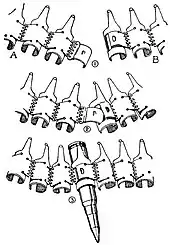
.jpg.webp)
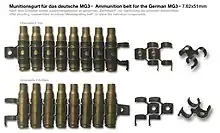
MG 3 machine guns are belt-fed from the left to the right side, using non-disintegrating metallic-link DM1 belts, which have links that wrap around the cartridge case and are linked by a coiling wire on each side. DM1 belts are intended for multiple reuse and in terms of design are based on and derived from the last version of the Gurt 34/41-belt family used in World War II in MG 34 and MG 42 machine guns.[16] DM1 belts are preloaded at ammunition factories in 50-round connectable belt lengths and can be linked to any length necessary. Spent cartridge cases are ejected downwards, and the emptied links are transported to the right.
Alternatively the MG3 can also be fed by disintegrating metal M13 link belts (designated DM60 by Germany) used by many NATO member states. M13 links are also used on the Dillon M134D Minigun, M60, FN MAG, HK21 and MG5 machine guns among others. The disintegrating metal belt is fed from the left side. Ejection of empty M13 links is to the right side, and spent cartridge cases are ejected downwards. The inexpensive M13 links are considered disposable.
Both belt types are of push-through type and use a metal lip that is arrested in the rim of the cartridges to correctly position and fix the cartridges in place. The feeding system is based on the direct push-through of the cartridge out of the belt link into the gun's chamber. Feed is performed in two steps by a pawl-type feeding mechanism that continues to move the belt during both the rearward and forward cycles of the reciprocating bolt, producing a smooth belt flow.
For field use there are several ammunition containers available. The Gurttrommel (belt drum) contains a 50-round DM1 or DM60 belt. The Gurttrommel is not a true magazine but holds a curled 50-round belt preventing it from snagging, twisting and getting stuck during mobile assaults. The steel DM2 ammunition box contains a 250-round DM1 belt and the smaller plastic DM40004 ammunition box contains a 100-round DM1 belt or a 120-round DM60/M13 belt. The German military tends to use non-disintegrating DM1 belts for general use and disintegrating DM60/M13 belts in vehicle or aircraft fixed MG3 mountings that allow for collecting the ejected link pieces for reuse.
Sights
The open-type iron sighting line has a relatively short 430 millimeters (16.9 in) radius and consists of a "∧-type" height adjustable front sight on a folding post and a leaf rear sight with an open V-notch sliding on a ramp, graduated from 200 to 1,200 meters (219 to 1,312 yd) in 100 meters (109 yd) increments. A flip-up anti-aircraft sight is attached to the receiver top just in front of the normal rear sight element.
Tripod
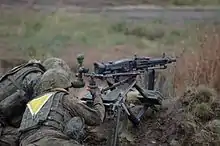
In a stationary, heavy machine gun role the MG 3 is mounted on a buffered Feldlafette ("field tripod") that also features storage containers for accessories like the Zielfernrohr 4 × 24 periscope-style telescopic sight. The direct fire only Zielfernrohr 4 × 24 sight like the MG 3 is mounted on the Feldlafette and is graduated from 0 to 1,600 meters (0 to 1,750 yd) in 100 meters (109 yd) increments. The Zielfernrohr 4 × 24 reticle can be illuminated by an external unit. It can also be used with the FERO-Z 51 night sight.[14]
A unique feature of the German World War II Feldlafette types that was not carried over to the MG3 Feldlafette was the Tiefenfeuerautomat ("in-depth automatic fire"). If selected, this feature walked the fire in wave like motions up and down the range between predefined ranges. This sweeping of a given range (Tiefenfeuer – "in-depth fire") continued as long as the gun was fired.
Reliability
In 1974 the US Army tested German made MG3s alongside eight other contemporary GPMG designs to replace the then-in-service M219 Tank Machine Gun, which was considered unacceptably unreliable by the US Army. The MG3 had a lower Mean Rounds Between Failure than 5 of the candidates including the M219 and a lower Mean Rounds Between Stoppages than 5 of the potential replacements, notably including the M60 Machine Gun, which was also considered a problematic design.[17]
Variants
- MG 1: Rheinmetall variant of the MG 42, most notably rechambered to fire 7.62×51mm NATO.
- MG 1A1 (MG 42/58): As MG 1, but with sights properly calibrated for the new round. Sights refitted to existing MG 1s.
- MG 1A2 (MG 42/59): MG 1A1 variant; product improved with longer ejection port, heavy bolt and friction ring buffer.
- MG 1A3: MG 1A2 variant; product improvement of all major components.
- MG 1A4: MG 1 variant; for fixed mount armor use.
- MG 1A5: MG 1A3 variant; MG1A3s converted to MG1A4 standard.
- MG 2: Designation for all wartime MG 42s rechambered to 7.62×51mm NATO.
- MG 3: MG 1A3 variant; product improved with AA rear sight.
- MG 3E: MG 3 variant; reduced weight model (roughly 1.3 kg lighter), entered into late 1970s NATO small arms trials.
- MG 3A1: MG 3 variant; for fixed mount armor use.
- MG 3KWS: MG 3 variant; developed by Rheinmetall and Tactics Group as a stand in until the HK121 replaces it.[18]
- MG 42/59: Italian variant produced by Beretta, Whitehead Motofides and Franchi, since 1959, Chambered in 7.62×51mm NATO. The bolt weight was increased to 1,200 g (42.33 oz)) for a reduced 800 rounds per minute cyclic rate of fire. Used mainly mounted on vehicles and has largely been phased out by the FN Minimi.
- Ksp m/94: Swedish variant chambered with the 7.62×51mm NATO round. Mainly used as secondary armament in Stridsvagn 122.
 Vehicle-mounted MG 3 (2019)
Vehicle-mounted MG 3 (2019) MG 3 in the heavy machine gun setup on a Feldlafette tripod with mounted optical sight
MG 3 in the heavy machine gun setup on a Feldlafette tripod with mounted optical sight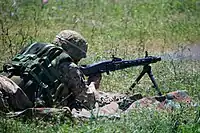 Italian soldier with MG 42/59 produced by Beretta
Italian soldier with MG 42/59 produced by Beretta.jpg.webp) Austrian Army soldiers with MG 74 and Steyr AUG during a maneuver
Austrian Army soldiers with MG 74 and Steyr AUG during a maneuver
Multiple barrel variants
A mounted variant with three rotating barrels (to reduce barrel erosion and overheating) is under development as the Rheinmetall RMG 7.62 as a vehicle weapon. Only one barrel is active at a time: after one barrel overheats, it is rotated out for a cool one.
The MG14z is a double barrel variant of the MG 3 machine gun with two MG 3 receivers paired together. The MG14z enhances the firepower of military units that still issue the MG 3 or other MG 42 derivatives. It has been developed by the Tactics Group GmbH company as "a low-cost alternative to Miniguns".[19]
Deployment
The MG 3 is still used as the standard secondary weapon of most modern German armoured fighting vehicle designs (e.g. Leopard 2, PzH 2000, Marder), as a primary weapon on light/non-armored vehicles (e.g. LKW 2to, MAN gl-trucks, ATF Dingo) and as an infantry weapon on light bipods as well as different tripods. The German Armed Forces have supplemented the MG 3 since 2015 with the Heckler & Koch MG5 in service.
Users





 Albania: Used by the Albanian Army.[20]
Albania: Used by the Albanian Army.[20] Afghanistan: Used by the Mujahideen and Taliban[21]
Afghanistan: Used by the Mujahideen and Taliban[21] Argentina: Used by the Argentine Army.[22]
Argentina: Used by the Argentine Army.[22].svg.png.webp) Australia: The MG 3 was used between 1976 and 2007 as an anti-aircraft weapon on the Australian Army's Leopard AS1 MBT.[23]
Australia: The MG 3 was used between 1976 and 2007 as an anti-aircraft weapon on the Australian Army's Leopard AS1 MBT.[23] Austria: Uses the MG 74 which is a MG 42/59 variant licensed from Beretta and manufactured by Steyr Mannlicher. The MG 74's cyclic rate of fire is 850 rounds per minute.[24]
Austria: Uses the MG 74 which is a MG 42/59 variant licensed from Beretta and manufactured by Steyr Mannlicher. The MG 74's cyclic rate of fire is 850 rounds per minute.[24] Azerbaijan: The Military of Azerbaijan acquired a small quantity of MKEK MG 3s from Turkey.
Azerbaijan: The Military of Azerbaijan acquired a small quantity of MKEK MG 3s from Turkey. Brazil: MG3 and MG3A1 are used by the Brazilian Army at the Leopard 1A5 BR.[25]
Brazil: MG3 and MG3A1 are used by the Brazilian Army at the Leopard 1A5 BR.[25].svg.png.webp) Canada: Only used on 20 Leopard 2A6M CAN tanks acquired from Germany.[26] Leopard 2s acquired from other sources will continue to use the FN MAG.
Canada: Only used on 20 Leopard 2A6M CAN tanks acquired from Germany.[26] Leopard 2s acquired from other sources will continue to use the FN MAG. Cape Verde[27]
Cape Verde[27] Chile[28]
Chile[28] Czech Republic: Used on Dingo 2.[29]
Czech Republic: Used on Dingo 2.[29] Denmark: MG 42/59 designated M/62 in Danish service.[30]
Denmark: MG 42/59 designated M/62 in Danish service.[30] Estonia[31] Designated as MG 3. MG 1A3 version with the anti-aircraft sight.
Estonia[31] Designated as MG 3. MG 1A3 version with the anti-aircraft sight. Finland: As the 7.62 KK MG 3. Used with the Leopard 2 tanks and NH90 helicopters.[32]
Finland: As the 7.62 KK MG 3. Used with the Leopard 2 tanks and NH90 helicopters.[32] Germany: Used by the Bundeswehr.[27]
Germany: Used by the Bundeswehr.[27] Ghana
Ghana Greece: License production by Hellenic Defense Systems or EAS (formerly Hellenic Arms Industry; Elliniki Biomihania Oplon – EBO).[22][33]
Greece: License production by Hellenic Defense Systems or EAS (formerly Hellenic Arms Industry; Elliniki Biomihania Oplon – EBO).[22][33] Iceland: Used by the Icelandic Coast Guard.[34]
Iceland: Used by the Icelandic Coast Guard.[34] Indonesia: License production[35]
Indonesia: License production[35] Iran: License production by Defense Industries Organization as the MGA3. Used by Iranian Army. Installed on Zulfiqar (tank)[28][36]
Iran: License production by Defense Industries Organization as the MGA3. Used by Iranian Army. Installed on Zulfiqar (tank)[28][36] Iraq: Peshmerga of Iraqi Kurdistan autonomous region, 40 MG3s supplied by Germany and 100 MG-42/59 by Italy[37]
Iraq: Peshmerga of Iraqi Kurdistan autonomous region, 40 MG3s supplied by Germany and 100 MG-42/59 by Italy[37] ISIL[4]
ISIL[4] Italy: License production of the MG 42/59 by Beretta with parts made by Whitehead Motofides and Luigi Franchi; while largely replaced in squad support weapon role by the Belgian FN Minimi, it still sees widespread mounted use on ground-based vehicles and helicopters.[28][38] Prior to the procurement of the Minimi, the Stabilimento Militare Armi Leggere (SMAL) at Terni has developed a kit to adapt the Italian Army's existing MG 42/59 machine guns to accommodate 5.56×45mm NATO ammunition. The kit comprises a new barrel, bolt head, feed opening and cover, recoil-enhancing element and a lighter bolt. The weight of the modified 5.56 mm MG 42/59 machine gun remains unchanged from the original version.
Italy: License production of the MG 42/59 by Beretta with parts made by Whitehead Motofides and Luigi Franchi; while largely replaced in squad support weapon role by the Belgian FN Minimi, it still sees widespread mounted use on ground-based vehicles and helicopters.[28][38] Prior to the procurement of the Minimi, the Stabilimento Militare Armi Leggere (SMAL) at Terni has developed a kit to adapt the Italian Army's existing MG 42/59 machine guns to accommodate 5.56×45mm NATO ammunition. The kit comprises a new barrel, bolt head, feed opening and cover, recoil-enhancing element and a lighter bolt. The weight of the modified 5.56 mm MG 42/59 machine gun remains unchanged from the original version. Latvia: Latvian Land Forces
Latvia: Latvian Land Forces Libya[35]
Libya[35] Lithuania: Lithuanian Armed Forces.[39]
Lithuania: Lithuanian Armed Forces.[39] Mexico: License produced by SEDENA in Mexico.[40]
Mexico: License produced by SEDENA in Mexico.[40] Myanmar[27] Clones made in Myanmar as the MA 15.[41]
Myanmar[27] Clones made in Myanmar as the MA 15.[41] Niger[3]
Niger[3] Nigeria[42]
Nigeria[42] Norway[27] used by Home Guard. Replaced in regular army by Minimi and FN MAG in 2019.
Norway[27] used by Home Guard. Replaced in regular army by Minimi and FN MAG in 2019. Pakistan: Used by the Pakistan Army.[43] Manufactured under license by Pakistan Ordnance Factories from 1960s in Wah Cantt.[44]
Pakistan: Used by the Pakistan Army.[43] Manufactured under license by Pakistan Ordnance Factories from 1960s in Wah Cantt.[44] Philippines: Used by the Philippine National Police.[45]
Philippines: Used by the Philippine National Police.[45] Poland: On Leopard 2 tanks and support vehicles. Intended to be replaced by UKM-2000 and WKM-B.[46]
Poland: On Leopard 2 tanks and support vehicles. Intended to be replaced by UKM-2000 and WKM-B.[46] Portugal[28]
Portugal[28] Sao Tome and Principe[27]
Sao Tome and Principe[27] Saudi Arabia[27]
Saudi Arabia[27] Spain: Made under license.[28]
Spain: Made under license.[28] Sri Lanka Used by the Sri Lankan Armed Forces in limited numbers.
Sri Lanka Used by the Sri Lankan Armed Forces in limited numbers. Sudan: Made by Military Industry Corporation as the Karar.[47]
Sudan: Made by Military Industry Corporation as the Karar.[47] Sweden: As the KSP m/94. Used with the Leopard 2 tanks.[48]
Sweden: As the KSP m/94. Used with the Leopard 2 tanks.[48] Thailand: Used on Commando V-150 APC.
Thailand: Used on Commando V-150 APC. Togo[27]
Togo[27] Tunisia[35]
Tunisia[35] Turkey: Made by MKEK in Kırıkkale under license since 1974[49] for the Turkish Armed Forces and Turkish Gendarmerie.[50]
Turkey: Made by MKEK in Kırıkkale under license since 1974[49] for the Turkish Armed Forces and Turkish Gendarmerie.[50] Yemen: pro-Saudi forces and Al-Qaeda in the Arabian Peninsula[51]
Yemen: pro-Saudi forces and Al-Qaeda in the Arabian Peninsula[51] Ukraine: Ukrainian armed forces have been given MG3 to aid them in the Russian invasion of 2022.[6]
Ukraine: Ukrainian armed forces have been given MG3 to aid them in the Russian invasion of 2022.[6] Uruguay[52]
Uruguay[52]
See also
- MG51—7.5×55mm Swiss general-purpose machine gun
- SIG 710-3—Swiss derivative of MG 42
References
Citations
- McNab, Chris (2002). 20th Century Military Uniforms (2nd ed.). Kent: Grange Books. p. 31. ISBN 1-84013-476-3.
- "Sudan – Global trade, local impact: Arms Transfers to all Sides in the Civil War in Sudan" (PDF). Human Rights Watch Report. 10 (4): 25. August 1998.
- Savannah de Tessières (January 2018). At the Crossroads of Sahelian Conflicts: Insecurity, Terrorism, and Arms Trafficking in Niger (PDF) (Report). Small Arms Survey. p. 58. ISBN 978-2-940548-48-4. Archived from the original (PDF) on June 12, 2018.
- "What It's Really Like to Fight for the Islamic State". Archived from the original on 2021-12-12 – via YouTube.
- Dnevnik (in Slovenian). Ljubljana, Slovenia: Radiotelevizija Slovenija. 2015. Event occurs at 17:13. Retrieved 8 August 2015.
- "1,500 Soviet Strela-2 MANPADS and 100 MG3 arrived in Ukraine". March 28, 2022.
- "Dv 3-14 Das Maschinengewehr" (PDF). commons.wikimedia.org.
- Woźniak, Ryszard: Encyklopedia najnowszej broni palnej—tom 3 M-P, page 106. Bellona, 2001.
- "MKEK – PRODUCT DETAILS". Archived from the original on 2009-09-15. Retrieved 2014-04-04.
- "Historical Firearms - Rheinmetall Machinengewehr 3 West Germany". www.historicalfirearms.info.
- Shepherd, Christian (17 January 2009). "Machine Gun 42". Tactical Life. Retrieved 2014-02-09.
- Gao, Charlie (August 24, 2019). "Bang: Meet the 5 Best Machine Guns on the Planet". The National Interest.
- "Harmonisierung bei den Handwaffen der Bundeswehr". esut.de. March 6, 2019.
- "ZDv 3/12. Schießen mit Handwaffen" (PDF) (in German).
- Jane's Infantry Weapons. Jane's Information Group. 2002. p. 2169.
- "Feeding the Tiger: Ammunition Belts for German MG 34 and MG 42 Machine Guns". www.smallarmsreview.com. March 2005.
- "attribute analysis of the armor machine gun candidates" (PDF). Archived (PDF) from the original on September 14, 2021. Retrieved 14 September 2021.
- Steve, Johnson (6 January 2014). "Bundeswehr MG3KWS Upgrade Program". The Firearm Blog. Retrieved 2014-01-19.
- "Tactics Group MG-14z - Trade Shows 2014 - IWA 2014 - all4shooters.com". all4shooters.com. Retrieved 2014-06-28.
- "The 45 Albanian Army Special forces face-to-face with the Taliban's in Kandahar, Afghanistan | Almex 2011 daily news albania defence exhibition | Defense exhibition 2011 daily news category". Armyrecognition.com. Retrieved 2022-03-10.
- McNab, Chris (2012). MG 34 and MG 42 Machine Guns. Osprey Publishing. p. 72.
- McNab, Chris (2012). MG 34 and MG 42 Machine Guns. Osprey Publishing. p. 70.
- "Leopard AS1 Main Battle Tank Part One by Paul D. Handel". Retrieved 2014-01-11.
- "Österreichs Bundesheer – Waffen und Gerät – Maschinengewehr MG 74". Bmlv.gv.at. Retrieved 2014-02-09.
- "Request Rejected" (PDF). www.exercito.gov.br. Archived from the original (PDF) on June 1, 2010.
- http://www.combatcamera.forces.gc.ca/netpub/server.np?find&catalog=photos&template=detail_eng.np&field=itemid&op=matches&value=9381&site=combatcamera
- Jones, Richard D.; Ness, Leland S., eds. (January 27, 2009). Jane's Infantry Weapons 2009/2010 (35th ed.). Coulsdon: Jane's Information Group. ISBN 978-0-7106-2869-5.
- "G3 Defence Magazine August 2010". En.calameo.com. 2010-08-04. Archived from the original on 2012-03-25. Retrieved 2014-02-09.
- "Obrněné vozidlo Dingo 2 CZ | Armáda ČR".
- "Maskingeværer". Archived from the original on 2017-05-15. Retrieved 2015-07-30.
- "Relvad – Kaitsevägi". Mil.ee. Retrieved 2022-07-14.
- "Puolustusvoimat" (in Finnish). Mil.fi. Archived from the original on 2008-04-23. Retrieved 2014-02-09.
- Moss, Matthew. "Rheinmetall Machinengewehr 3". Historical Firearms. Retrieved 2021-06-12.
- "Hátt í 400 hríðskotabyssur í landinu". RÚV. 27 October 2014. Retrieved 2014-10-27.
- Jenzen-Jones, N.R.; McCollum, Ian (April 2017). Small Arms Survey (ed.). Web Trafficking: Analysing the Online Trade of Small Arms and Light Weapons in Libya (PDF). Working Paper No. 26. p. 85. Archived from the original (PDF) on May 16, 2017.
- "AIG". www.diomil.ir. Archived from the original on October 30, 2008.
- Small Arms Survey (2015). "Trade Update: After the 'Arab Spring'" (PDF). Small Arms Survey 2015: weapons and the world (PDF). Cambridge University Press. p. 110. Archived from the original (PDF) on July 1, 2015.
- "Esercito Italiano: Il Portale delle Armi dei Materiali e dei Mezzi". www.esercito.difesa.it. Archived from the original on May 20, 2011.
- (in Lithuanian) Lietuvos kariuomenė :: Ginkluotė ir karinė technika » Kulkosvaidžiai » Kulkosvaidis MG-3 Archived 2015-11-02 at the Wayback Machine. Kariuomene.kam.lt (2009-04-17). Retrieved on 2010-10-18.
- "Mexico Mexican army land ground forces military equipment armoured vehicle pictures information desc - Army Recognition". Retrieved 2014-01-11.
- "信息提示".
- Jowett, Philip (2016). Modern African Wars (5): The Nigerian-Biafran War 1967–70. Oxford: Osprey Publishing Press. p. 20. ISBN 978-1472816092.
- "Pakistan Army". Defence.pk. Archived from the original on 2013-05-13. Retrieved 2014-02-09.
- "POF – Machine Gun MG3 (MG1A3)". Pof.gov.pk. Archived from the original on 2013-10-29. Retrieved 2014-02-09.
- "News". Manila Bulletin. 6 May 2019.
- "Pierwsze strzelanie żołnierzy NSR z karabinu maszynowego MG-3". Wojsko Polskie. 2013-06-15. Archived from the original on 2013-06-15. Retrieved 2021-05-10.
- "Military Industry Corporation (MIC) Official Website". mic.sd. Archived from the original on March 10, 2008.
- Henrik Svensk. "Strv122 Stridsvagn 122 Leopard 2". Soldf.com. Retrieved 2014-02-09.
- "Mkek - Product Details". www.mkek.gov.tr. Archived from the original on February 10, 2012.
- "Si̇lahlar". www.jandarma.tsk.mil.tr. Archived from the original on April 14, 2009.
- Austin, Rod (28 Nov 2018). "Yemen: inquiry finds Saudis diverting arms to factions loyal to their cause". The Guardian.
- InfoDefensa, Revista Defensa. "El Ejército de Uruguay recibe un millar de ametralladoras MG-3 adquiridas a España". Infodefensa - Noticias de defensa, industria, seguridad, armamento, ejércitos y tecnología de la defensa (in Spanish). Retrieved 20 April 2022.
General and cited references
- Ezell, Edward C. (1988). Small Arms Today 2nd Edition. Harrisburg, PA: Stackpole Books.
- Woźniak, Ryszard (2001). Encyklopedia najnowszej broni palnej—tom 3 M-P (in Polish). Warsaw: Bellona. ISBN 83-11-09311-3.
External links
- Bimbel.de—MG3 disassembled
- Bimbel.de—MG3 on mount
- MG 3 video
- Video simulation of how a MG 3 works on YouTube
- Machine Gun MG3 (MG1A3)
- 7.62 mm MG3 MACHINE GUN Archived 2009-09-15 at the Wayback Machine
- ZDv 3–14 Das Maschinengewehr.pdf ZDv 3/14 Das Maschienengewehr (German)
- Das Maschinengewehr MG3